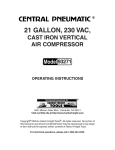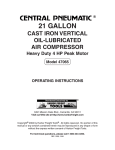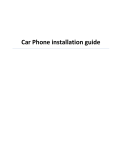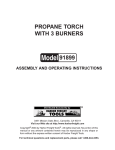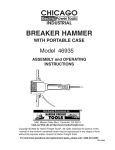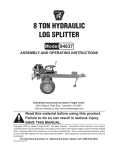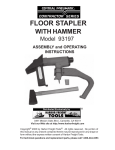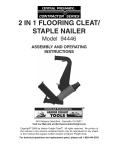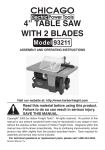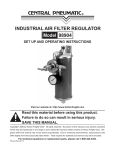Download Harbor Freight Tools 42696 User's Manual
Transcript
MINI LOG SPLITTER 6 TON 42696 ASSEMBLY & OPERATING INSTRUCTIONS ® 3491 Mission Oaks Blvd., Camarillo, CA 93011 Visit our Web Site at www.harborfreight.com 3 Revised cover page 04/06 THANK YOU for choosing a HARBOR FREIGHT TOOLS product. For future reference, please complete the owner’s record below: Model______________ Serial No.______________ Purchase Date_____________ SAVE THE RECEIPT, WARRANTY AND THESE INSTRUCTIONS. It is important that you read the entire manual to become familiar with the unit BEFORE you begin assembly. Technical Specifications Tool Name: Item Number: Log Capacity: Overall: Handle Length: Cylinder Capacity: Cylinder: Length: Base Rails: Base Support: Cutter Support: Uprights: Retaining Pins: Weight: Log Splitter - Mini 6 Ton 42696 27" Long 8" Diameter 14-7/8" L x 15-1/8" W x 44-3/8" H 12" 6 Ton Hydraulic 8" 0.160 Angle Iron 0.112" Mild Steel 0.312" Mild Steel 0.125" 0.390 OD x 2-1/2" L 34 LBS. Safety Warnings and Precautions WARNING: When using product, basic safety precautions should always be followed to reduce the risk of personal injury and damage to equipment. Read all instructions before using this product! 1. Keep work area clean. Cluttered areas invite injuries. 2. Keep children away. Children must never be allowed in the work area. 3. Store idle equipment. When not in use, tools must be stored in a dry location to inhibit rust. Always lock up tools and keep out of reach of children. 4. Do not force tool. It will do the job better and more safely at the rate for which it was intended. Do not use inappropriate attachments in an attempt to exceed the tool capacity. 5. Use the right tool for the job. Do not attempt to force a small tool or attachment to do the work of a larger industrial tool. There are certain applications for which this tool was designed. Do not modify this tool and do not use this tool for a purpose for which it was not intended. #42696 Page 2 6. Use eye and ear protection. Always wear ANSI approved impact safety goggles. Wear a full face shield if you are producing metal filings or wood chips. Wear an ANSI approved dust mask or respirator when working around metal, wood, and chemical dusts and mists. 7. Dress properly. Do not wear loose clothing or jewelry as they can be caught in moving parts. Protective, electrically non-conductive clothes and non-skid footwear are recommended when working. Wear restrictive hair covering to contain long hair. 8. Stay alert. Watch what you are doing, use common sense. Do not operate any tool when you are tired. 9. Check for damaged parts. Before using any tool, any part that appears damaged should be carefully checked to determine that it will operate properly and perform its intended function. 10. Replacement parts and accessories. When servicing, use only identical replacement parts. Use of any other parts will void the warranty. Only use accessories intended for use with this tool. Approved accessories are available from Harbor Freight Tools. 11. Do not operate tool if under the influence of alcohol or drugs. Read warning labels on prescriptions to determine if your judgment or reflexes are impaired while taking drugs. If there is any doubt, do not operate the tool. 12. Observe area conditions. Do not use product in damp or wet locations. Do not expose to rain. 13. Do not overreach. Keep proper footing and balance at all times. Do not reach over or across the Log Splitter. Never place hands or feet between the log and splitter wedge or between the log and ram during the forward or reverse stroke. 14. Never leave the product unattended while in operation. 15. Remove adjusting keys and wrenches. Check that keys and adjusting wrenches are removed from the tool or machine work surface before operating. 16. Never place your hands or other body parts near a hydraulic fluid leak. Never check for a leak with your hands or other body parts. High-pressure fluid can be forced under your skin resulting in serious injury. 17. Never attempt to split two logs on top of each other. Warning: The warnings, cautions, and instructions discussed in this instruction manual cannot cover all possible conditions and situations that may occur. It must be understood by the operator that common sense and caution are factors which cannot be built into this product, but must be supplied by the operator. Warning: This product contains or produces a chemical known to the State of California to cause cancer and birth defects (or other reproductive harm). (California Health & Safety Code 25249.5 et seq.) Assembly Your Log Splitter will require complete assembly prior to operation. It is important that you read the entire manual to become familiar with the unit BEFORE you use the Log Splitter. Before assembling your Log Splitter be sure that you have all parts described in the Parts List. When assembling your Log Splitter, it will be helpful to refer each of the operational Figures as well as to the Parts List and Assembly Diagram on the last pages of this manual. Assemble attachments based on the intended use of the Log Splitter. Mounting Surface: The mounting surface must be flat, level and capable of supporting the weight of the Log Splitter combined with the materials to be split. #42696 Page 3 The following part numbers correspond to Parts List “A”. Step 1) Slide the Blade Assembly (#4A) onto the Upper Frame Assembly (#2A). Line up the holes in the Blade Assembly (#4A) with those in the Upper Frame Assembly (#2A). Insert one Support Pin (#14A) through each set of holes. With the Support Pin completely through the Blade Assembly (#4A) and Upper Frame Assembly (#2A), insert a Hair Pin Clip (#20A) through each Support Pin (#14A)-see Figure 1 below. Step 2) Slide the Upper Frame Assembly (#2A) onto the Lower Frame Assembly (#3A). Insert one Support Pin (#13) through each set of holes. Once the Support Pin(#13) is fully through both the Upper Frame Assembly (#2A) and the Lower Frame Assembly (#3A) insert a Hair Pin Clip (#20) through each Support Pin (#13). Upper Frame Assembly (#2A) Hair Pin Clip (#20A) Blade Assembly (#4A) Support Pin (#14A) Attaching the Base Step 1) Figure 1 To attach the two Base Support Assemblies (#9A) to the Lower Frame Assemblies (#3A) set one Base Support Assembly (#9A) on each side of the Lower Frame Assemblies as in Figure 3. Step 2) There are 3 Hex Head Bolts (#17A) on each side. For each side, insert two of the Hex Head Bolts (#17A) through the Base Support Assembly (#9A), through the Lower Frame Assembly (#03A) and through the other Base Support Assembly-see Figure 3. Step 3) Secure in place with two Hex Nuts (#18A) on each side. Step 4) To the inside of each Lower Frame Assembly there is another hole in the Base Support Assembly. Into this hole insert a Hex Head Bolt (#17A) through the Base Support Assembly (09A), then through a Bushing (8A) and out through the second Base Support Assembly (09A). Secure in place with Hex Nut (#18A)-see Figure 3. Step 5 Thread a Hex Nut (#10A) onto each Hook Screw (#11A) and thread the Hook Screws up into the bottom of Jack Support (#1A) Also thread a Nex Nut (#10A) onto the Hook Screw as it protrudes up through the Base (#1B). See Assembly Diagram - Page 8. Connect a Spring (#12A) between each Hook Screw (#11A), and Bushing (#8A). Adjust each Hook Screw so that tension is equal for both Springs (#12A). Once properly adjusted, tighten the Hex Nuts (#10A), below and above the Base (#1B), against the Base (#1B). Step 6) Attach each Base Assembly (#5A) and Supporting Plate (#7A) to the Lower Frame Assemblies (#3A). Place two Supporting Plates so that the hole in the end lines up with the hole in the Lower Frame Assembly (#3A); the Supporting Plates (#7A) will have to overlap. Insert Hex Head Bolt (#16A) through the Supporting Plates and through the Lower Frame Assembly (#3A) and hand tighten on Hex Nut (18A)-see Figure 3. Repeat for second side. Step 7) Secure the other end of each Supporting Plate (#7A) to one end of the Base Assembly (#5A) as in Figure 3. Insert Hex Head Bolt (#15A) and tighten on Hex Nut (#18A). Tighten Hex Nut (#18A) from Step 5. Repeat for second side. Step 8) Insert Hex Head Bolt (#16A) through the middle hole in the Base Assembly (#5A) and through the Lower Frame Assembly (#3A), secure in place with Hex Nut (18A). Step 9) Insert Lock Pin (#22A) down through Hydraulic Jack (#6A) and through Base Support Assembly (#9A). Insert Hair Pin Clip (#20A) through Lock Pin (#22A) to secure in place. Warning: #42696 Do not open the Release Valve (#4B) when the Log Splitter is supporting a load. Page 4 Figure 3 Hex Head Bolt (#17A) Lower Frame Assembly (#3A) Hex Nut (#18A) Supporting Plate (#7A) Hex Head Bolt (#16A) Lock Pin (#22A) Hair Pin Clip (#20A) Base Support Assembly (#9A) Bushing (#8A) Base Assembly (#5A) Mounting The Base Assembly (#5) will accept 3/8" Bolts (not included). Step 1) Set the Log Splitter firmly on its mounting surface. Warning: The Log Splitter must be securely mounted to a work surface prior to use! Step 2) Make certain that you can operate the Jack Handle (#19A) comfortably. Step 3) Mark the surface through the two holes located at the far ends of the Base Assembly (#5A). Step 4) Remove the Log Splitter from the surface to be mounted. Drill holes through the marked locations. Step 5) Mount the unit using four bolts, lock washers, washers and nuts (in that order) sold separately. Operation When operating your Log Splitter, it may be helpful to refer to each of the operational Figures as well as to the Parts List and Assembly Diagram located on the last pages of this manual. Never force the tool or attachment to do the work of a larger industrial tool. It is designed to do the job better and more safely at the rate for which it was intended. Do not exceed the tools maximum capacity. Filling the Pump Reservoir Hydraulic Fluid: When filling the pump reservoir, make certain to use a high quality hydraulic fluid. The fluid should be changed at every 300 hours of use. Step 1) Clean the area around the filler cap to remove all dust and grit. Step 2) With the Jack Handle (#19A) in place, turn the Jack Handle (#19A) counterclockwise. This will retract all cylinders to their return position. Step 3) Remove the Filler Plug (#33B). Measure the level of fluid in the tank visually. Using a clean funnel with a filter, fill the Reservoir (#29B) with hydraulic fluid up to the top. Replace the Filler Plug (#33B). #42696 Page 5 Bleeding the System If any air becomes trapped in the system during initial connections or at a later time, the following steps should be taken to bleed the system. Note: Air in the system will cause the ram to rise and fall as the handle is pumped. If the ram does not fully extend, add oil through the Filler Plug (#33B). Step 1) Step 2) Place the Jack Handle (#19A) on the Release Valve. Open the Release Valve (#4B) by turning the Jack Handle (#19A) counterclockwise. Open the Filler Plug (#33B) on the side of the jack. Step 3) Pump the Jack Handle (#19A) rapidly several times. Step 4) Close the Release Valve (#4B) by turning the Jack Handle (#19) fully clockwise. Test the function of the jack, and repeat, if necessary. Handle Sleeve (#27B) Plastic Cap Safety Valve (#10B) (DO NOT ADJUST) Release Valve (#4B) Figure 2 Replace the Filler Plug (#33B). Step 5) Caution: When not in use, make sure pressure is released by turning the Jack Handle fully counterclockwise. This will prolong the life of the Log Splitter. Operating the Log Splitter Note: Make sure the Release Valve (#4B) is turned fully clockwise to the closed position. Step 1) Make certain that the maximum length of each log to be split does not exceed 27". If the log exceeds this length, it must be cut to no longer than 27". The logs diameter is not to exceed 8". Step 2) Place the Log between the Jack Support (#1A) and the Blade Assembly (#4A). Step 3) Insert the Jack Handle (#19A) into the Handle Sleeve (#27B)-see Figure 2. The Jack Handle must fit into the Handle Sleeve (#27B) firmly. Turn the Jack Handle (#19A) until you feel it slide securely into place. Step 4) Pumping the Jack Handle (#19A) up and down will raise the Jack Support up to the Blade Assembly (4A) until the log is split. Warning: Keep clear of the area surrounding the log while it is being split. Be alert to falling sections of the log as it is split. Keep spectators well clear of the work area while the Log Splitter is being used. Step 5) Once the Log is split, slowly release the Release Valve (#4B) by turning counterclockwise and remove the pieces from the Log Splitter. To back the Blade Assembly (#4A) off of the log, turn the Jack Handle (#19A) counterclockwise. This will release the pressure and lower the Hydraulic Jack. Step 6) Continue the preceding steps until all logs have been split. #42696 Page 6 Maintenance CLEANING: After every use, wipe down the Log Splitter to remove any tree sap or dirt that has accumulated during use. This will extend the use of the Log Splitter. Keep machined parts lightly greased. Prevent wood, dust and debris from accumulating on the Log Splitter. STORAGE: Childproof the machine and work area. Make sure to use padlocks (not included) and to secure the Log Splitter after operation. IF THERE IS ANY QUESTION ABOUT A CONDITION BEING SAFE OR UNSAFE, DO NOT OPERATE THE TOOL. PLEASE READ THE FOLLOWING CAREFULLY THE MANUFACTURER AND/OR DISTRIBUTOR HAS PROVIDED THE PARTS DIAGRAM IN THIS MANUAL AS A REFERENCE TOOL ONLY. NEITHER THE MANUFACTURER NOR THE DISTRIBUTOR MAKES ANY REPRESENTATION OR WARRANTY OF ANY KIND TO THE BUYER THAT HE OR SHE IS QUALIFIED TO MAKE ANY REPAIRS TO THE PRODUCT OR THAT HE OR SHE IS QUALIFIED TO REPLACE ANY PARTS OF THE PRODUCT. IN FACT, THE MANUFACTURER AND/OR DISTRIBUTOR EXPRESSLY STATES THAT ALL REPAIRS AND PARTS REPLACEMENTS SHOULD BE UNDERTAKEN BY CERTIFIED AND LICENSED TECHNICIANS AND NOT BY THE BUYER. THE BUYER ASSUMES ALL RISK AND LIABILITY ARISING OUT OF HIS OR HER REPAIRS TO THE ORIGINAL PRODUCT OR REPLACEMENT PARTS THERETO, OR ARISING OUT OF HIS OR HER INSTALLATION OF REPLACEMENT PARTS THERETO. Unpacking UNPACK AND CHECK CONTENTS When unpacking your Log Splitter, check to make sure the following parts are included. If any parts are missing or broken, please call HARBOR FREIGHT TOOLS at 1-800-444-3353. Parts List Part # Description 1A Jack Support 2A Upper Frame Assembly 3A Lower Frame Assembly 4A Blade Assembly 5A Base Assembly 6A Hydraulic Jack 7A Supporting Plates 8A Bushing 9A Base Support Assembly 10A Hex Nut M8 11A Hook Screw M 8 x 90 Quantity 1 2 2 1 1 1 2 2 1 4 2 Part # 12A 13A 14A 15A 16A 17A 18A 19A 20A 21A 22A Description Spring Support Pin 10 mm x 40 Support Pin 10 mm x 60 Hex Head Bolt M 10 x 20 Hex Head Bolt M 10 x 50 Hex Head Bolt M 10 x 60 Hex Nut M 10 Jack Handle Hair Pin Clip 50 mm Hair Pin Clip 25 mm Lock Pin Quantity 2 2 2 4 4 6 14 1 4 1 1 Note: Some parts are listed and shown for illustration purposes only and are not available individually as replacement parts. #42696 Page 7 Assembly Diagram- Main Parts List “A” #42696 Page 8 Parts List Part # Description 1B Base 2B Ball 1/4" 3B Seal 4B Release Valve 5B Ball 1/4" 6B Spring Plunger 7B Spring-Safety Valve 8B Screw-Safety Valve 9B O-Ring 10B Plastic Cap-Safety Valve 11B Cotter Pin 12B Pin 13B Cap Washer 14B Cylinder 15B O-Ring 16B Cup Seal 17B Ram Piston Quantity 1 3 1 1 1 1 1 1 1 1 1 1 1 1 1 1 1 Part # 18B 19B 20B 21B 22B 23B 24B 25B 26B 27B 28B 29B 30B 31B 32B 33B 34B Description Ram Washer Pump Cylinder Cup Seal Back-Up Ring O-Ring Pump Plunger Handle Rubber Handle Handle Sleeve Packing Reservoir Reservoir Packing Reservoir Top Nut O-Ring Filler Plug Filter Quantity 1 1 1 1 1 1 1 1 1 1 1 1 1 1 1 1 1 Note: Some parts are listed and shown for illustration purposes only and are not available individually as replacement parts. Assembly Diagram- Jack Parts List “B” #42696 Page 9









